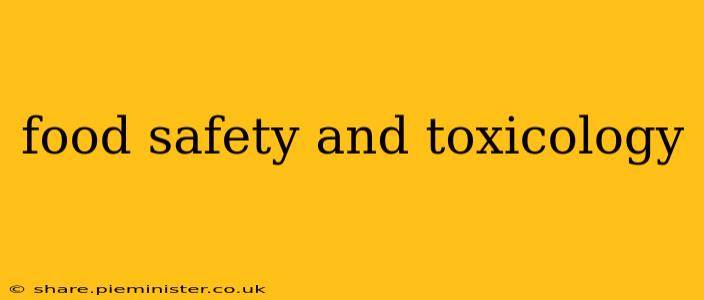Food safety and toxicology are critical fields ensuring the food we consume is safe for human consumption. This intersection of science and public health focuses on identifying, assessing, and mitigating the risks associated with foodborne hazards. This comprehensive guide delves into the key aspects of food safety and toxicology, exploring the various hazards, regulatory frameworks, and preventative measures.
What are the Main Hazards in Food?
Food hazards encompass biological, chemical, and physical contaminants that can compromise food safety. Biological hazards include bacteria (like Salmonella and E. coli), viruses (such as norovirus and hepatitis A), parasites (like Toxoplasma gondii), and fungi (including molds and mycotoxins). Chemical hazards originate from pesticides, heavy metals (such as lead and mercury), naturally occurring toxins (like aflatoxins), and food additives. Finally, physical hazards are foreign objects like glass, metal, or plastic that accidentally contaminate food during production, processing, or handling. Understanding these hazards is crucial for implementing effective food safety measures.
What are the Key Principles of Food Safety?
Several core principles underpin safe food handling and preparation. Hazard Analysis and Critical Control Points (HACCP) is a systematic preventative approach to food safety from biological, chemical, and physical hazards in production processes. This system identifies critical control points (CCPs) where hazards can be prevented, eliminated, or reduced to safe levels. Other essential principles include maintaining proper hygiene practices, such as thorough handwashing and surface sanitization; cooking food to safe internal temperatures; storing food at appropriate temperatures (refrigeration or freezing); and preventing cross-contamination between raw and cooked foods. Adherence to these principles is fundamental to minimizing foodborne illnesses.
What is Food Toxicology?
Food toxicology specifically studies the harmful effects of chemical substances present in food on human health. It investigates how toxins interact with the body, causing adverse effects ranging from mild discomfort to severe illness or even death. Toxicologists conduct research to determine the toxicity of various substances, establishing safe exposure limits to protect consumers. This scientific discipline is crucial for setting regulations and standards for food safety, ensuring that food products are free from harmful levels of toxins.
What are the different types of foodborne illnesses?
Foodborne illnesses, also known as food poisoning, result from consuming contaminated food or beverages. The symptoms vary widely depending on the causative agent and the individual’s susceptibility. They can range from mild gastrointestinal distress (nausea, vomiting, diarrhea) to more severe complications such as dehydration, kidney failure, or even death in vulnerable populations. The incubation period (time between consumption and symptom onset) also differs significantly between pathogens. Prompt medical attention is crucial for severe cases.
How are food safety regulations developed and enforced?
Food safety regulations are developed and enforced by governmental agencies to protect public health. These regulations cover various aspects of food production, processing, distribution, and retail, aiming to minimize foodborne illnesses. Agencies like the Food and Drug Administration (FDA) in the United States and the European Food Safety Authority (EFSA) in Europe play crucial roles in setting safety standards, inspecting food facilities, and investigating outbreaks. These regulations are constantly reviewed and updated based on scientific advancements and emerging hazards.
What are some tips for preventing foodborne illnesses at home?
Preventing foodborne illnesses at home involves practicing safe food handling and preparation techniques. This includes washing hands thoroughly before and after handling food; cleaning and sanitizing surfaces; separating raw and cooked foods; cooking food to safe internal temperatures; refrigerating perishable foods promptly; and avoiding cross-contamination. Following these simple steps significantly reduces the risk of food poisoning.
What is the role of food labeling in ensuring food safety?
Food labeling plays a vital role in informing consumers about food safety and composition. Labels provide crucial information such as ingredients, nutritional values, allergen warnings, and storage instructions. Accurate and clear labeling allows consumers to make informed choices about the food they buy and consume, helping them avoid potential hazards. Regulatory bodies ensure that food labels comply with legal requirements and provide accurate information.
In conclusion, food safety and toxicology are interconnected disciplines crucial for protecting public health. Understanding the various hazards, adhering to safe food handling practices, and complying with food safety regulations are essential for preventing foodborne illnesses and ensuring a safe and secure food supply. Continuous research and advancements in these fields are vital for adapting to evolving challenges and maintaining the highest standards of food safety worldwide.
